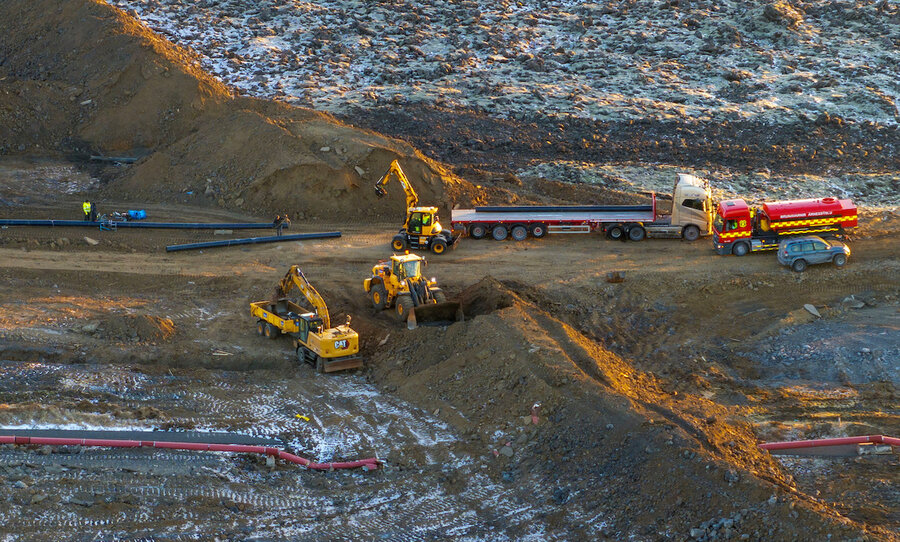Race against time: Icelanders build towering structures to stop lava
Loading...
| Copenhagen
Icelanders are working round-the-clock to build dykes the size of three-story buildings to protect a vital power plant and homes from lava flows, since volcanoes near the capital Reykjavik that were dormant for nearly 800 years became active.
The six volcanic systems, which experts forecast will be active for up to three centuries, stretch under Iceland’s southwestern Reykjanes peninsula, home to 30,000 people, nearly 8% of the country’s total population.
They form an underground meshwork on the peninsula, stretching to the edges of the capital, which has witnessed five eruptions since 2021.
Amid concerns about an imminent eruption, authorities in November began building defense walls around the peninsula’s Svartsengi geothermal power plant.
Since then, nearly 100 bulldozers, excavators, and haul trucks have been working nonstop around the plant, according to Kristinn Hardarson, who heads operations at energy company HS Orka, the owner of Svartsengi.
In total, some 560,000 cubic meters of gravel and solidified lava rock – enough to fill 20,000 trucks – will be used to protect the plant.
“They have to divert the lava so it flows beside the barriers. If you try to stop it, the lava will just build up and eventually go over the barriers,” Vidir Reynisson, head of Iceland’s Civil Protection and Emergency Management, told Reuters.
Construction of defenses has also started around the nearby town of Grindavik, home to one of Iceland’s key fishing ports and nearly 4,000 residents who were evacuated in December before the most recent eruption north of the town.
The first barrier proved effective in diverting lava away from Grindavik but when fissures opened on the other side of the barrier, lava reached the town and set some houses alight.
The biggest barriers are about 40 meters wide, between eight and ten meters high, and four meters wide at the top.
Finishing the seven-kilometer half circle around Grindavik is expected to take six weeks, Mr. Reynisson said.
It will take roughly twice as much material as was needed at Svartsengi, according to Ari Gudmundsson, a civil engineer at Verkis, an engineering company working on the barriers.
Similar dykes or embankments have been attempted in Italy, Hawaii, and Iceland to protect from lava but on a smaller scale, according to Mr. Gudmundsson.
When Mount Etna, an active volcano in Italy, erupted in late 1991, a 234-meters long and 21-meters high barrier was constructed. The lava was held back for approximately one month before it eventually flowed over the structure.
Icelanders first attempted building defense walls on the island of Heimaey when a 1973 eruption ravaged the town of Vestmannaeyjar, forcing its entire population to evacuate.
Numerous eruptions have struck Iceland since, but usually away from towns and critical infrastructure. When volcanic activity began on the Reykjanes peninsula in 2021, fresh attempts at building a defense were made.
“We made a few barriers, short ones, to get experience and to try to steer the lava flow away from one area that would eventually lead to Grindavik,” Mr. Gudmundsson said.
Engineers are trying to fine-tune how tall and steep the barriers should be.
“The main thing we saw is that the barriers are working, so now we know more about how to build them and how to use them,” Mr. Reynisson said.
The Department for Civil Protection is also digging hot water pipelines deeper underground and lifting power and telecom lines higher to protect them.
Attempts are also being made to insulate overland pipelines and power cables from hot lava.
Icelanders have an ambiguous relation to volcanoes, according to Sigurdur Ingi Johannsson, Iceland’s Minister of Infrastructure.
We must remember that our green geothermal energy, amazing tourist attractions, and well-being in Iceland come from the power of the volcanoes, he told Reuters.
“Sometimes it is good and a benefit to the people, but sometimes it is threatening us.”
This story was reported by Reuters.







